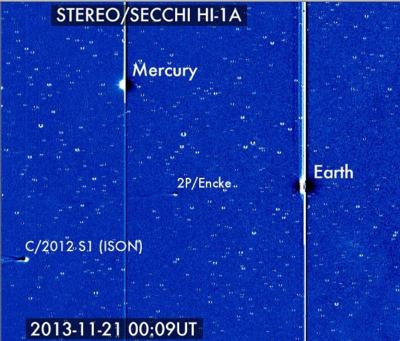Tue, Nov 26, 2013
Comet Will Slingshot Around The Sun Thanksgiving Day
It began in the Oort cloud, almost a light year away. It has traveled for over a million years. It has almost reached the star that has pulled it steadily forward for so long. On Thanksgiving Day, Nov. 28, 2013, Comet ISON will finally sling shot around the sun. Here its inward journey through the solar system will end -- either because it will break up due to intense heat and gravity of the sun, or because, still intact, it speeds back away, never to return.

Catalogued as C/2012 S1, Comet ISON was first spotted 585 million miles away in September 2012. Scientists were instantly intrigued, not because spotting it so far away meant it might be very bright and beautiful once it was closer to Earth -- though this may indeed turn out to be the case if it survives its trip around the sun -- but because this is ISON's very first trip into the inner solar system. That means it is still made of pristine matter from the earliest days of the solar system's formation, its top layers never having been lost by a trip near the sun. Along Comet ISON's journey, NASA has used a vast fleet of spacecraft and Earth-based telescopes to learn more about this time capsule from when the solar system first formed.
During the last week of its inbound trip, ISON will enter the fields of view of several NASA Heliophysics observatories. Comet ISON will be viewed first by the broad field of view seen by NASA's Heliospheric Imager instrument aboard its Solar Terrestrial Relations Observatory, or STEREO, Next the comet will be seen in what's called coronagraphs, images that block the brighter view of the sun itself in order to focus on the solar atmosphere, the corona. Such images will come both from STEREO and the joint European Space Agency/NASA Solar and Heliospheric Observatory, or SOHO. Then, NASA's Solar Dynamics Observatory, or SDO, will view the comet for a few hours during its closest approach to the sun, known as perihelion. The X-Ray Telescope on the JAXA/NASA Hinode mission will also be looking at Comet ISON for about 55 minutes during perihelion.
All of these observatories will have different views. STEREO-B will be the only one that sees the comet transit across the face of the sun. In SDO's view, the comet will appear to travel above the sun, and the SDO instruments will point away from the center of the sun to get a better view for three hours on Nov. 28. In addition to learning more about the comet itself, these observations can make use of the comet as a tracer to show movement in the solar wind and solar atmosphere.
(Image provided by NASA)
More News
From 2023 (YouTube Version): Legacy of a Titan Robert (Bob) Anderson Hoover was a fighter pilot, test pilot, flight instructor, and air show superstar. More so, Bob Hoover was an i>[...]
Get The Latest in Aviation News NOW on Instagram Are you on Instagram yet? It's been around for a few years, quietly picking up traction mostly thanks to everybody's new obsession >[...]
Aero Linx: B-52H Stratofortress The B-52H Stratofortress is a long-range, heavy bomber that can perform a variety of missions. The bomber is capable of flying at high subsonic spee>[...]
Altimeter Setting The barometric pressure reading used to adjust a pressure altimeter for variations in existing atmospheric pressure or to the standard altimeter setting (29.92).>[...]
"Knowing that we play an active part in bettering people's lives is extremely rewarding. My team and I are very thankful for the opportunity to be here and to help in any way we ca>[...]
 Classic Aero-TV: Remembering Bob Hoover
Classic Aero-TV: Remembering Bob Hoover ANN FAQ: Follow Us On Instagram!
ANN FAQ: Follow Us On Instagram! ANN's Daily Aero-Linx (05.15.24)
ANN's Daily Aero-Linx (05.15.24) ANN's Daily Aero-Term (05.15.24):Altimeter Setting
ANN's Daily Aero-Term (05.15.24):Altimeter Setting Aero-News: Quote of the Day (05.16.24)
Aero-News: Quote of the Day (05.16.24)



